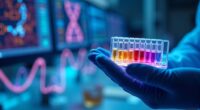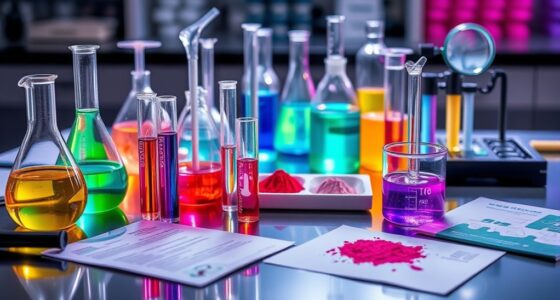Pharmacokinetics explains how your body absorbs, distributes, metabolizes, and eliminates medicines, shaping how well they work and how safe they are. When you take a drug, it moves into your bloodstream, spreads through tissues, and gets broken down mainly in the liver. It then exits your body through urine, bile, or other routes. Understanding these processes helps doctors dose medicines correctly; stay tuned to learn how models predict these drug journeys.
Key Takeaways
- Pharmacokinetics explains how the body absorbs, distributes, metabolizes, and excretes drugs to determine their effects.
- Absorption, bioavailability, distribution, metabolism, and excretion are the four main processes affecting drug levels.
- Factors like genetics, age, drug interactions, and food influence how drugs move through and act in the body.
- The route of administration and tissue affinity impact how quickly and effectively a drug reaches its target.
- Mathematical models help predict drug behavior, optimize dosing, and personalize treatments based on individual patient characteristics.
What Is Pharmacokinetics and Why Is It Important?
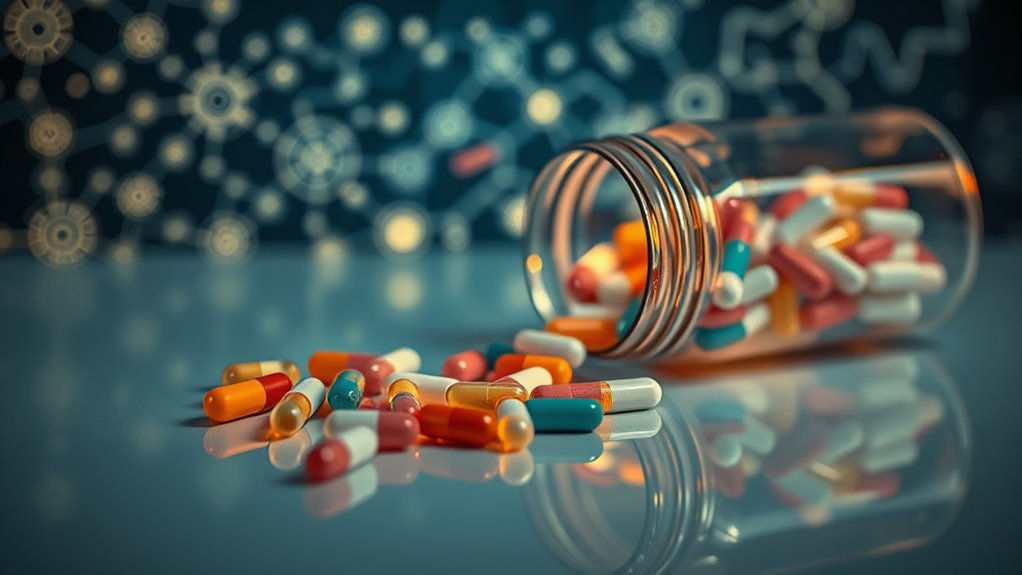
Pharmacokinetics, often called PK, explains how your body interacts with and processes a drug from the moment you take it until it’s fully eliminated. It describes the movement of a drug into, through, and out of your body, focusing on what your body does to the medication. PK involves analyzing how your body metabolizes the drug and what happens to it from administration to elimination. It uses mathematical models to link drug concentrations in your plasma with time, helping predict how the drug behaves. Understanding PK is crucial because it guides appropriate dosing, ensures safety, and improves efficacy. It also helps develop better drugs and personalize treatments by considering how different people process medications differently. Recognizing the tax implications of medications and treatments can also impact overall health management.
The Four Key Processes: Absorption, Distribution, Metabolism, and Excretion

Understanding how your body processes a drug involves examining four key steps: absorption, distribution, metabolism, and excretion.
Absorption is how the drug moves from its administration site into your bloodstream. Factors like how you take the drug, its formulation, and chemical properties influence this process. Bioavailability shows how much of the drug reaches your target; for example, IV drugs have 100%. Bioavailability can vary depending on the route of administration and formulation, impacting the drug’s overall effectiveness. Oral drugs may undergo first-pass metabolism in the liver, reducing their effectiveness, which can be mitigated by alternative delivery methods.
Next, distribution spreads the drug through your bloodstream to tissues, with factors like blood flow and tissue affinity playing roles.
Metabolism breaks down the drug into metabolites, mainly in the liver, affecting its activity.
Finally, excretion eliminates the drug via urine, bile, lungs, or feces, determining how long the drug stays active.
Factors That Influence How Drugs Move Through the Body

Factors That Influence How Drugs Move Through the Body
Multiple factors can influence how drugs move through your body, impacting their absorption, distribution, metabolism, and excretion. Your genetic makeup affects liver enzymes like CYP450, altering how quickly you metabolize certain medications, which can change their effectiveness and toxicity. Genetic differences can lead to variability in drug responses among individuals. Age also plays a role; older adults often have slower metabolism and reduced kidney function, leading to drug buildup, while infants have immature enzyme systems requiring careful dosing. Drug interactions matter too—some drugs induce enzymes, speeding up metabolism, while others inhibit enzymes, causing drug levels to rise. Additionally, food and other substances can affect absorption and transporter proteins like P-glycoprotein, influencing how drugs are absorbed and distributed. These factors collectively determine your body’s response to medication. Furthermore, the presence of AI-driven diagnostics can assist in tailoring drug therapies to individual patients, optimizing efficacy and safety.
How Drugs Are Absorbed and Distributed After Administration

After a drug enters your body, the way it’s absorbed depends largely on the route of administration and the surrounding environment. Oral drugs dissolve in the stomach and small intestine, but their absorption can be delayed by food or digestive issues. The pH of the environment and the drug’s pKa influence the proportion of un-ionized, lipid-soluble forms that cross membranes more easily. Buccal and sublingual routes allow drugs to enter the bloodstream directly, bypassing the liver’s first-pass effect, leading to faster effects. Intravenous injections deliver drugs straight into circulation, ensuring immediate availability. The site of administration influences how quickly and how much drug gets absorbed, based on membrane permeability and blood flow. Lipid-soluble drugs cross membranes easily, while others rely on carrier molecules or active transport. Once absorbed, drugs circulate in the bloodstream, distributing to tissues depending on blood flow, tissue permeability, and how much they bind to proteins. Additionally, understanding drug distribution helps clinicians predict how drugs will act in different tissues and whether they reach therapeutic levels.
The Role of Metabolism and Excretion in Clearing Drugs
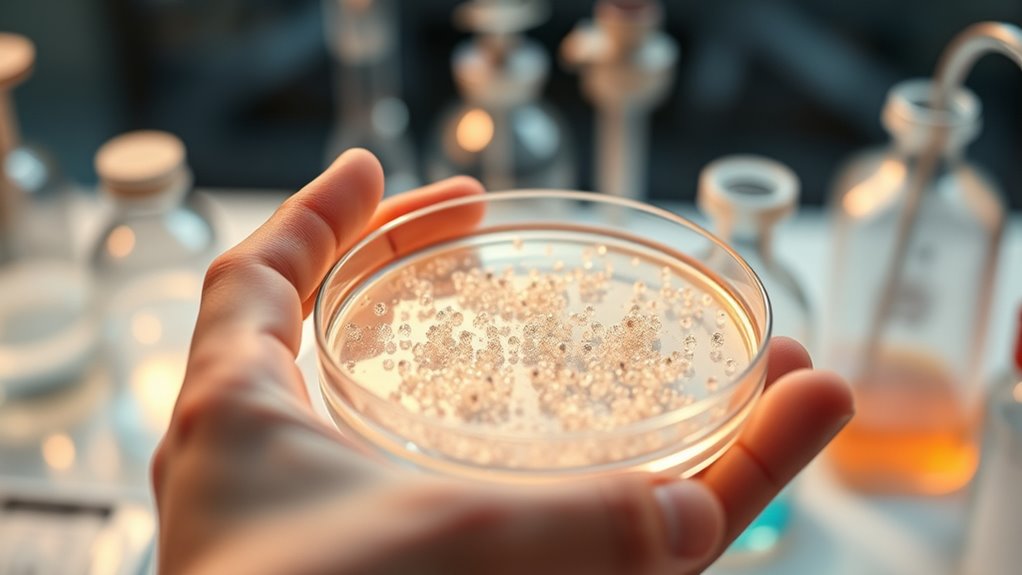
Metabolism and excretion are essential processes that remove drugs from your body, ensuring they don’t accumulate to harmful levels. Your liver primarily metabolizes drugs through enzymatic reactions, like those involving cytochromes P450, converting them into more water-soluble forms. Extrahepatic tissues such as the kidneys, lungs, and skin also participate in metabolism. Excretion mainly occurs via the kidneys through filtration and active secretion, with some drugs eliminated through bile, breath, sweat, saliva, or breast milk. Factors like renal function, age, and health conditions influence how efficiently drugs are cleared. Here’s an overview:
| Site of Clearance | Role in Excretion |
|---|---|
| Kidneys | Main route via urine |
| Liver (bile) | Excretion into intestines |
| Lungs | Volatile drugs via exhalation |
| Sweat & Saliva | Minor routes |
| Mammary glands | Excretion into breast milk |
Additionally, understanding the metabolic pathways involved in drug processing can help optimize dosing and minimize adverse effects.
How Mathematical Models Help Predict Drug Behavior
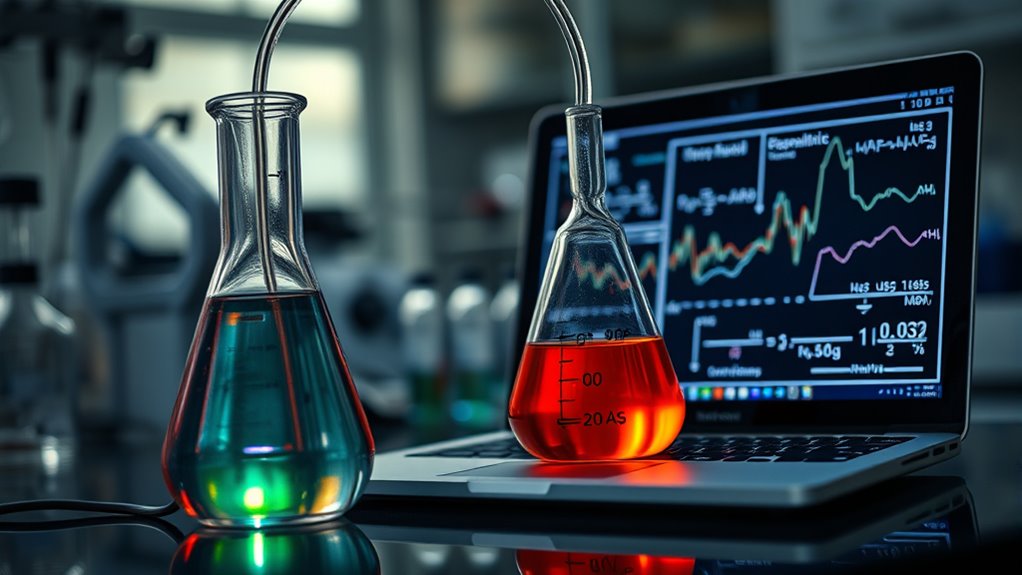
Mathematical models are powerful tools that help you understand and predict how drugs behave within the body. They use equations to represent absorption, distribution, metabolism, and elimination, giving you a detailed picture of concentration-time profiles in tissues and plasma. These models are used across disciplines like medicine to simulate biological and disease processes, enabling safer testing of medications. By incorporating physiological and biochemical parameters, these models simulate how different dosing regimens impact drug levels and responses, reducing the need for extensive in vivo testing. They also factor in patient-specific variables like age, weight, and organ function, enabling personalized predictions. Additionally, these models assess complex drug interactions, including multi-drug therapies, helping you understand synergistic or antagonistic effects. Understanding pharmacokinetics allows clinicians to optimize treatment plans and improve therapeutic outcomes.
The Connection Between Pharmacokinetics and Drug Effectiveness
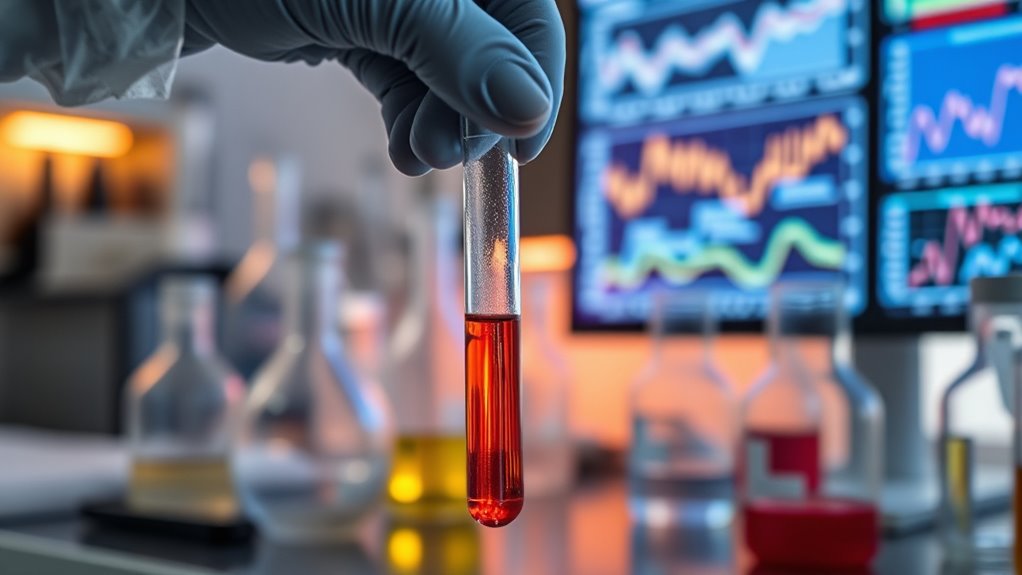
Have you ever wondered how the way a drug is absorbed influences its ability to produce a therapeutic effect? When a drug enters your bloodstream, the rate and amount absorbed determine its bioavailability, which is *vital* for effectiveness. Factors like drug formulation, how you take it, and your gut environment can change absorption, making some drugs less effective.
If absorption is poor, plasma levels might drop below what’s needed for the desired response. Once absorbed, the drug travels through your blood to target tissues. The amount reaching the receptor site impacts how well it works.
Variations in distribution, metabolism, or excretion can alter drug levels, influencing how strong or long-lasting the effect will be. Understanding these connections helps optimize your treatment outcomes.
Frequently Asked Questions
How Do Genetic Differences Affect Pharmacokinetics in Individuals?
You should know that genetic differences can considerably influence how your body processes medications. Variations in genes like CYP2D6, CYP2C9, and CYP2C19 affect enzyme activity, altering drug metabolism rates.
These differences can impact drug effectiveness, increase toxicity risk, or cause side effects. By understanding your genetic makeup, healthcare providers can personalize dosing, improving safety and therapeutic outcomes while reducing adverse reactions.
What Is the Impact of Age and Health Status on Drug Processing?
Age and health status profoundly shape your body’s drug processing.
As you age, your water decreases and fat increases, affecting drug distribution.
Kidney and liver functions slow down, reducing drug clearance and metabolism.
Chronic health issues and polypharmacy further complicate responses.
You might experience heightened sensitivity and side effects, requiring personalized dosing, careful monitoring, and mindful medication management to guarantee safety and effectiveness in your treatment.
How Do Drug Interactions Alter Pharmacokinetic Profiles?
You see, drug interactions can markedly change how your body handles medications. They may alter absorption by affecting stomach pH or binding to minerals, impacting how much drug gets into your bloodstream.
Interactions can also change distribution by modifying protein binding or tissue uptake. Additionally, they might inhibit or induce liver enzymes, speeding up or slowing down drug metabolism.
These changes can lead to subtherapeutic effects or toxicity, affecting treatment outcomes.
What Are Common Challenges in Modeling Drug Pharmacokinetics?
Imagine trying to map a shifting maze with fog swirling around. Common challenges in modeling drug pharmacokinetics include incomplete human data, which leaves gaps in your map, and complex absorption paths that twist unpredictably.
You also face hurdles like physiological variability and ethical barriers, making it tough to create accurate, all-encompassing models. Without clear, exhaustive data, your predictions risk being lost in the fog of biological complexity.
How Does Pharmacokinetics Vary Between Different Routes of Administration?
You’ll notice that pharmacokinetics varies greatly depending on how you deliver the drug. For example, intravenous administration gives you immediate effects with full bioavailability.
While oral routes involve absorption through the gastrointestinal tract, leading to slower onset and variable bioavailability. Injections like IM and SC provide more controlled, sustained release.
Topical applications usually target localized effects with lower systemic absorption. Each route influences onset, duration, and overall drug effectiveness.
Conclusion
Understanding pharmacokinetics is like knowing the map to a treasure chest—you’ll find it easier to predict how your body handles medicines. By grasping absorption, distribution, metabolism, and excretion, you can better appreciate how drugs work and why they vary from person to person. This knowledge acts as your compass, guiding safer and more effective treatments. When you understand these processes, you’re better equipped to navigate your health journey with confidence.

